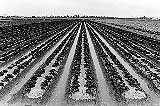
| ch. 5, pp. 57 - 59 |
Cotton is the predominant crop grown in TAMA, accounting for about 75 percent of planted acreage. Other crops grown include wheat, barley, sorghum, alfalfa hay, vegetables, nuts, millet and lettuce. Pecans are the predominant crop grown at FICO. The cost of pumping groundwater for TAMA farmers depends mainly on the depth to groundwater and energy costs. With access to low-cost hydropower generated at Hoover Dam, CMID has about the lowest pumping cost in TAMA. The district controls well pumping and supplies water to farmers at a cost of $30 per acre-foot, plus an annual assessment of $40 per acre for every acre in the district. Individual farmers within AVID have their own wells and control water use decisions. Pumping costs for wells in the district were about $40 to $50 per acre foot in 1995, including operation, maintenance and repair costs. Average pumping cost for FICO wells was recently reported to be $28 per acre foot. To encourage farms to use renewable supplies such as CAP water the cost of such supplies needs to be comparable to the cost of pumped groundwater. When originally offered to irrigation districts in Arizona, CAP water cost more than pumped groundwater. As a result, fewer irrigation districts than expected signed subcontracts for CAP water. Many irrigation districts that did sign subcontracts faced a financial crisis, if not bankruptcy, until the State of Arizona offered incentives to increase CAP water use by agriculture. The state offered irrigation districts who had signed a CAP subcontract a reduced price for the water in return for irrigation districts giving up their long-term right to use CAP water. Since none of the irrigation districts in the Tucson AMA signed subcontracts to use CAP water, they were not eligible for these favorably priced allotments of CAP water. TAMA farms, however, are eligible to use CAP water under another incentive program designed to encourage CAP water use. Under the Groundwater Savings Facilities (GSFs), otherwise known as in-lieu recharge facilities, municipal water providers offer CAP water to farmers at prices below the cost of pumping groundwater. Farms use this CAP water in lieu of groundwater that otherwise would have been pumped. Municipal providers get credits for this “saved” groundwater. The credits then can be used in the future to offset groundwater pumping in efforts to meet state groundwater pumping restrictions.
As is shown in Table 5-3, CAP water use through the groundwater savings program has grown from about 10,000 acre-feet in 1995 to 25,000 acre-feet in 1997. CAP water use through GSFs continues to expand as new facilities are added and existing facilities are permitted to take more water. For example, CMID used almost 10,000 acre-feet of CAP water as a groundwater savings facility in 1997 and has increased its state permit to take up to 20,000 acre-feet per year of CAP water in the future. A groundwater savings facility located within AVID includes several farms. The AVID GSF is permitted to take up to 12,513 acre-feet per year of CAP water. FICO does not use any CAP water currently but is investigating the use of CAP and/or effluent. Use of CAP water at FICO could occur through a GSF with a possible capacity of up to 20,000 acre-feet per year. Kai Farms at Picacho, in the Red Rock area, converted from pecan trees to row crops in 1997, and irrigation with CAP water began under a grou ndwater savings project arrangement. Total CAP water used at the Kai Farm at Picacho GSF in 1997 was 6,701 acre-feet. The facility is permitted to take up to 11,231 acre-feet per year of CAP water. A small amount of treated effluent is used on farms in the Tucson area. CMID purchases an average of about 3,000 acre-feet of effluent per year from Pima County. The effluent is delivered via a ditch from the Ina Road treatment plant and is blended with groundwater for delivery to farms. Reducing Agricultural Water Use ADWR has goals for increasing water use efficiency on farms. In 1980, water use efficiency in TAMA averaged about 65 percent of water applied. This means that the average amount of water applied to crops was 35 percent greater than the calculated water need for those crops after accounting for the consumptive use requirement for the crops, the amount of precipitation available for plant growth, any additional water for special needs for crops — such as water needed for germination of lettuce — and a leaching allowance to prevent buildup of salts in the soil. The water use efficiency goal set for farms to reach by the year 2000 is 85 percent efficiency. ADWR reports that many farms have already reached this goal, but other farming operations are not certain whether this goal is attainable.
Flood irrigation on sloped fields is the most common irrigation method in TAMA. Some farms have saved water by laser-leveling their fields (a method of leveling and slightly sloping fields so that water spreads evenly across the field) or installing systems to pump back water that accumulates at the end of the field. Installation of drip irrigation systems is generally considered too expensive for irrigation in the Tucson area. ADWR also is requiring farms to make their distribution systems more efficient. Farms can save water by lining their water distribution canals with concrete or other materials. Under ADWR’s Second Management Plan, farms were required to either line all their canals or operate their delivery systems to keep lost or unaccounted water at less than ten percent. The agency reports that most of the largest irrigation districts in TAMA are meeting this requirement. One of the biggest factors in reducing agricultural water use in the Tucson area has been purchase of agricultural land for subdivision use, especially in the Marana area. As municipal development continues in the Tucson area, more farmland will likely be converted. Whether or not the new land use will ultimately consume more water depends on many factors. In situations in which farmland is converted to apartment or business use, the total water use will probably be less than the agricultural use. In situations in which farmland is converted to high-water uses such as golf courses, total water use may be higher.
|


